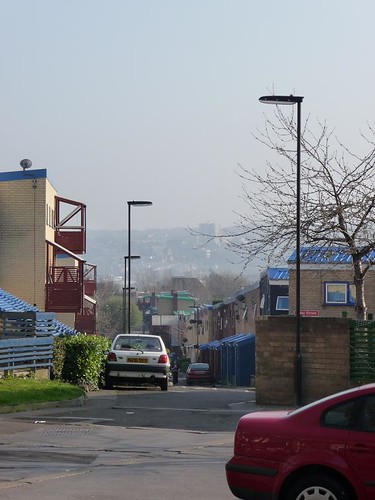And the other was Byker Grove (“Spuggy, I’m blind…”)
In the days when the latter programme was being broadcast I was studying GCSE geography. My education just missed the New Labour investment package, so my textbooks were so out-of-date they included odd case studies, like the Eldon Square Shopping Centre as an exciting new development in Newcastle city centre and also the Byker estate and Byker Wall. The estate has always been famous because of its architecture, but not infamous because of its architecture like, say, Hutchesontown C. In fact my GCSE Geography textbook included Byker because of how famously different it was.
If you don’t know the story, the architect Ralph Erskine was brought in by Newcastle City Council because they were well aware that the previous approach of slum clearance and high-rise flats for redevelopment was not working well. The shine of the new homes swiftly wore off as people realised they didn’t offer what their previous terraced homes had. After leaving the UK for Sweden as a conscientious objector, Erskine took a very different approach to doing architecture. He set up his office in the Byker neighbourhood and the slums were cleared slowly and each community worked closely with Erskine to deliver what they wanted. The design of the estate is striking, with the high Byker Wall to the north, following the topography of the area and protecting the low-rise homes and maisonettes to the south from the northerly weather. Supposedly the climate on the south side of the wall is on average 2 degrees warmer than the rest of the city. It was upgraded to Grade II* listing in 2007.
So Byker is famous as a model of fantastic architecture and community involvement in architecture, planning and urban design. So when I first had the opportunity to visit in 2008 I jumped at the chance. However, when I got off this visit, I discovered my digital camera had not recorded all the photos, but I got a couple:

The estate was looking very run down at this point and one section in the south, Bolem Coyne, was earmarked for demolition But I fell in love with the neighbourhood and its unique design. It was very sad and it felt like the council had just decided to disinvest in it. On a student fieldtrip two weeks ago I arranged to go again and was shown around by an incredibly enthusiastic housing officer who loved the estate and its design. Luckily this time my camera did work. The transformation was stunning and I was very pleased to see Bolem Coyne had been recently renovated and saved and was looking absolutely fantastic:

Quite a few things struck me. First, like many neighbourhoods, including my two PhD case studies (£), although it is very deprived (in the most deprived 1% of the English IMD) this deprivation was inadvertently locked in from the start. The neighbourhood had and continues to have very high rents because it is very good quality housing and was expensive to build. It was developed around the same time housing benefit emerged. Therefore any tenants who received housing benefit in the estate are effectively locked into a benefits trap worse than if they were living in more affordable housing elsewhere. Whereas in London I imagine Byker would have been gentrified long ago, in Newcastle to less buoyant local economy means that most residents are unemployed and therefore very few people have had the resources to exercise the Right-To-Buy; that and also the non-standard construction methods mean it’s very difficult to get a mortgage for a property in Byker.
Secondly, the estate now shows that neighbourhood management and place-based investment work. The housing officer explained that the listing meant they had access to more money and so began renewal works across the estate. Prior to this Newcastle Council had attempted to run it like any other neighbourhood, and with a complex interesting neighbourhood like Byker, this just did not work. The really exciting thing for the future is now owned by a Community Land Trust, so hopefully it will go from strength to strength.
Finally, much was made of the problems of anti-social behaviour on the estate. The estate’s urban design is Radburn to the max. The idea was people would park their cars next to the dual carriageway to the north of the wall and walk to their houses on the south side. The streets are therefore very much like rabbit warrens and brilliant non-car urban design. Unfortunately, they also do absolutely everything you shouldn’t do if you want to “design-out” crime. This got me thinking: it is a striking, wonderful neighbourhood, with a fantastic sense of place, and the streetscape, as much as the buildings, are central to this. Does designing out crime mean we never achieve such striking neighbourhoods that are so pedestrian friendly because we always need wide streets with sight lines?
I’m reading a fantastic book to review at the moment about place-making and it really struck me that if you want a definition of a place then Byker is it. It looks fantastic and the pride the community now have for their neighbourhood means it is looking fantastic. The housing officer told a nice tale of how the kids from Byker think they’re better than the kids from the other estates in the east end because, although they’re poor, they’re from Byker. Although, I do think some of the Ralph Erskine community engagement stuff is a myth – the estates he built in Scandinavia look an awful lot like Byker…
No comments:
Post a Comment